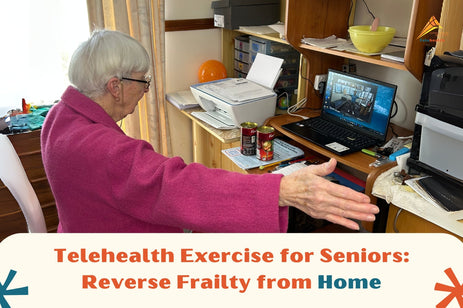
The concept of neuroplasticity—the brain’s ability to reorganise and form new neural connections—has become a key focus in understanding how to maintain brain health while aging. Emerging research shows that physical exercise not only strengthens the body but also promotes neuroplasticity, helping the aging brain stay sharp, adaptable, and resilient.
At Summit Health Solutions, we’ve seen how movement can empower older adults to stay active, independent, and mentally engaged. Through our Telehealth Exercise Program—a structured, group-based initiative designed for aging adults—we help participants move confidently from home while nurturing both body and brain health.
What Is Neuroplasticity—and Why Does It Matter?
Neuroplasticity refers to the brain’s ability to reorganise itself by forming new neural connections throughout life. According to Harvard Health, neuroplasticity allows the brain to adapt to learning, recover from injury, and respond to new experiences—even in older age.

For aging adults, this means the brain isn’t “set in stone.” With the right stimuli, such as exercise and mental health practices, it can strengthen pathways related to memory, coordination, mood, and cognition.
However, as people age, structural and functional brain changes naturally occur—like reduced grey matter and slower processing. Regular neuroplasticity and exercise habits can counteract these changes, helping preserve mental agility and promote lifelong learning.
How Physical Exercise Boosts Neuroplasticity
Exercise and the Brain: Building New Connections
Engaging in consistent physical exercise stimulates the release of brain-derived neurotrophic factor (BDNF)—a key molecule for creating and maintaining neural connections. Research from the National Institute on Aging found that lifelong aerobic fitness is linked to healthier white-matter pathways in the brain, essential for efficient communication between brain regions.
This means when you move your body, you’re literally helping your brain wire itself more effectively. Exercise encourages new cell growth in the hippocampus (the area responsible for memory and learning) and improves overall blood flow, supplying oxygen and nutrients vital for cognitive function.
Cognitive Benefits of Exercise
For seniors, the benefits of exercise in seniors extend far beyond physical strength:
-
Sharper memory and focus: Aerobic and coordination activities help reinforce neural pathways linked to attention and learning.
-
Improved mood: Physical activity stimulates endorphins and serotonin, supporting mental health in seniors and reducing symptoms of depression.
-
Better executive function: Exercise enhances planning, multitasking, and decision-making—crucial for independent living.
A review in Trends in Neurosciences emphasises that consistent activity helps preserve cognitive flexibility and protect against age-related decline (Cell Journal).
Neuroplasticity and Exercise: The Science Behind Movement
When we move, our brain releases growth factors such as BDNF, IGF-1, and VEGF, which encourage neuron survival and new synaptic connections. Exercise also:
-
Improves cerebral blood flow, enhancing nutrient delivery to the brain.
-
Reduces inflammation and oxidative stress, both of which accelerate brain aging.
-
Activates different regions of the brain, depending on the activity type—strength training, for example, stimulates coordination and motor control centres.
Even modest movement counts. The World Health Organization highlights that 150 minutes of moderate activity per week can significantly boost both physical and mental well-being.
How Aging Adults Can Use Exercise to Support Brain Health
1. Combine Aerobic, Strength, and Balance Training
A well-rounded routine supports neuroplasticity best. Aim for:
-
Aerobic exercise (walking, cycling, swimming) for cardiovascular and brain stimulation.
-
Strength training (light weights, resistance bands) for coordination and muscular health.
-
Balance and flexibility activities (yoga, tai chi) to enhance sensory feedback and motor learning.
-
Dual-task activities, like walking while reciting words or following rhythm, to challenge both brain and body simultaneously.
2. Start Small, Stay Consistent
If you’ve been inactive, even gentle movement can make a difference. Research shared by Neuroscience News shows that moderate activity stimulates brain cell growth—even when started later in life.
Consistency matters more than intensity. Small steps—literally—add up to lasting brain benefits.
3. Make It Accessible and Enjoyable
Many aging adults face barriers like transport, weather, or mobility limitations. That’s where home-based programs such as Summit Health Solutions’ Telehealth Exercise Program can be transformative. Participants enjoy:
-
Live online group sessions guided by professionals.
-
Recorded sessions for flexible scheduling.
-
Safe, modified exercises suitable for all ability levels.
-
New themes every two months to maintain engagement.
While it’s a group program (not individualised coaching), it’s structured, supportive, and built around evidence-based routines that keep the brain and body active.
4. Pair Physical Activity With Mental Engagement
Neuroplasticity thrives when the brain is challenged. Try pairing physical exercise with brain games, music, or conversation. The University of Sydney notes that combining movement and cognitive activity strengthens learning and attention networks in older adults.
A Holistic Approach to Healthy Aging
Exercise doesn’t just improve strength—it builds confidence, community, and mental clarity. By joining regular sessions and staying socially connected, aging adults foster a sense of belonging that supports emotional and brain health.
To explore more about how movement supports mood, read our related article “Healthy Aging Through Self-Care: How Physical Activity Boosts Mental Health”.
Frequently Asked Questions (FAQs)
1. Can neuroplasticity still occur in older adults?
Yes! The brain retains the ability to adapt throughout life. Stimulating it through exercise and the brain activities enhances memory, attention, and problem-solving skills.
2. How much exercise is recommended for cognitive health?
For adults aged 50–64 years and those 65 and above, the World Health Organization (WHO) and Australian Department of Health recommend doing at least 150 minutes of moderate-intensity physical activity per week, or 75 minutes of vigorous-intensity activity, or a combination of both. Including muscle-strengthening exercises on two or more days further supports overall health and cognitive function.
3. Does strength training support neuroplasticity?
Absolutely. Resistance exercises enhance motor control and coordination, improving brain network efficiency and cognitive performance.
4. Are virtual exercise programs as effective as in-person classes?
Yes. Research shows that guided online group sessions maintain physical activity levels, motivation, and social connection—key drivers of brain health. Summit Health’s telehealth model ensures safety and engagement for all participants.
5. Can exercise prevent dementia or cognitive decline?
Exercise cannot guarantee prevention, but it’s one of the strongest protective factors. Studies show that combining regular movement, social engagement, and mental challenges lowers risk and slows decline.
Final Thoughts
Movement is one of the most powerful ways to nurture neuroplasticity and keep the aging brain active and adaptable. Every walk, stretch, or strength session signals your brain to keep learning, adapting, and connecting.
If you or a loved one wants to stay active from the comfort of home, join our Telehealth Exercise Program—a safe, evidence-based way to stay strong, connected, and cognitively engaged.
Your body moves—and your brain grows stronger with every step.























